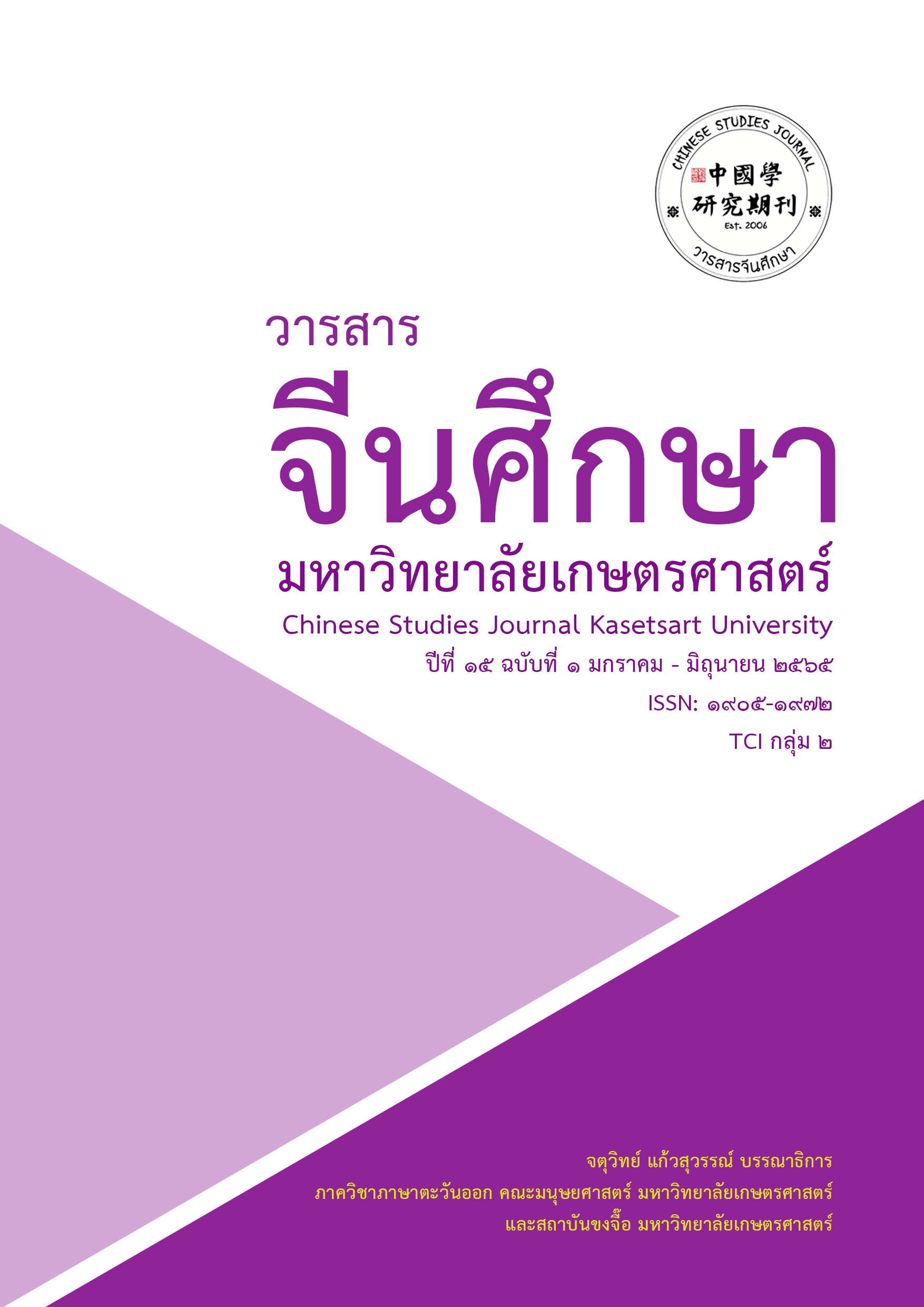Comparative Study of Right to Life and Bodily integrity of Female Under the Lan Na and Chinese Law During the 14th – 17th Centuries การเปรียบเทียบสิทธิส่วนบุคคลของสตรีด้านสิทธิในชีวิตและร่างกายตามกฎหมายล้านนาและกฎหมายจีน ช่วงคริสต์ศตวรรษที่ 14 – 17
Main Article Content
Abstract
This article aims to study the similarities and differences of women's individual rights in terms of Right to Life and Bodily integrity under the Lan Na law and Chinese law during the 14th and 17th centuries from “The Ancient Lan Na Laws: An Analysis of its Legal Structure and Texts as Inscribed in Palmleaves From Time Immemorial” VOL. 3 Book. 1 - 8 and “the Great Ming Code” (Da Ming Lü大明律怀效锋点校). The author summarizes the characteristics of the Lan Na law and the Chinese law of the Ming dynasty and divide them into 4 issues: 1. The right to choose life partner, 2. The right to Life and Bodily integrity in the case of smuggling, 3. The right to Life and Bodily integrity in the case of adultery, 4. The right to Life and Bodily integrity in the event of rape. The results show that the Lan Na law and the Chinese law of the Ming dynasty are similar in the case of smuggling or rape, which is quite protective of the victim. However, in the case of adultery, the law judges that the husband is the victim, thus it’s legal for the husband to kill his unfaithful wife and her adulterer, and it’s also legal for the husband to sell or order his wife to remarry. The act above is considered a violation of the human rights of an adulterous woman. In addition, both of the Lan Na law and the Chinese law of Ming dynasty reflect the social hierarchy, because the punishment is also based on the social hierarchy of the perpetrator and the victim. The difference between the Lan Na law and the Chinese law of Ming dynasty is the punishment measures, for example, there’s a set of Five Punishments (wuxing 五刑) in the Great Ming Code, in order from the lighter to heavier, such as flogging by a light stick (chi 笞), flogging by a heavy stick (zhang 杖), penal servitude away from one’s native place (tu 徒) in five durations between one and three years, banishment (liu 流) at three distances between 2,000 and 3,000 li, and the death penalty, which is divided into strangulation (jiao 绞) decapitation (zhan 斩), and slicing (lingchi 凌迟). While in the Lan Na law, most of the punishment is imposing a fine. But in some cases, the perpetrator is sentenced to death, when the perpetrator is a slave while the victim is a woman of high status. Another difference is that women in Lan Na society have the right and freedom to choose life partner while most of the women of the Ming dynasty not, which reflects the difference of customs between Lan Na and Ming dynasty of China.
Article Details

This work is licensed under a Creative Commons Attribution-NonCommercial-NoDerivatives 4.0 International License.
ผลงานทางวิชาการที่ลงตีพิมพ์ในวารสารจีนศึกษา มหาวิทยาลัยเกษตรศาสตร์ เป็นลิขสิทธิ์ของผู้เขียนหรือผู้แปลผลงานนั้น หากนำลงในวารสารจีนศึกษาเป็นครั้งแรก เจ้าของผลงานสามารถนำไปตีพิมพ์ซ้ำในวารสารหรือหนังสืออื่นได้โดยมิต้องแจ้งให้ทราบล่วงหน้า แต่หากผลงานที่ได้รับพิจารณานำลงในวารสารจีนศึกษา เป็นผลงานที่เคยตีพิมพ์ที่อื่นมาก่อนเจ้าของผลงานต้องจัดการเรื่องปัญหาลิขสิทธิ์กับแหล่งพิมพ์แรกเอง หากเกิดปัญหาทางกฎหมาย ถือว่าไม่อยู่ในความรับผิดชอบของวารสารจีนศึกษา มหาวิทยาลัยเกษตรศาสตร์ ทั้งนี้ ความคิดเห็นต่างๆ ในบทความเป็นความคิดเห็นส่วนตัวของผู้เขียน ไม่เกี่ยวกับกองบรรณาธิการวารสารจีนศึกษา มหาวิทยาลัยเกษตรศาสตร์
References
กนกพร นุ่มทอง. (2020). หลักฐานล้านนาในเอกสารโบราณจีน: บันทึกเกี่ยวกับอาณาจักรสนมแปดร้อยในพงศาวดารหมาน พงศาวดารราชวงศ์หยวน พงศาวดารราชวงศ์หยวนฉบับใหม่และเจาปู๋จ่งลู่.วารสารจีนศึกษา, 13(1), 157-227.
กนกพร นุ่มทอง. (2020). หลักฐานล้านนาในเอกสารโบราณจีน: บันทึกเกี่ยวกับอาณาจักรสนมแปดร้อยในเอกสารโบราณสมัยราชวงศ์หมิงและราชวงศ์ชิง. วารสารจีนศึกษา, 13(2), 1-112.
ชายไทย รักษาชาติ. (2004). การเปรียบเทียบความสัมพันธ์เชิงอำนาจหญิงชายในกฎหมายมังราย ศาสตร์กับกฎหมายไทยในมุมมองแนวสตรีนิยม. วิทยานิพนธ์ปริญญามหาบัณฑิต สาขาการวิจัยและพัฒนาท้องถิ่น มหาวิทยาลัยราชภัฏเชียงใหม่.
ทูนศรี บัวนุช. (1992). การศึกษาความหมายในกฎหมายจารีตมังรายศาสตร์. วิทยานิพนธ์ศิลปศาสตรมหาบัณฑิต สาขาวิชาภาษาและวรรณกรรมล้านนา มหาวิทยาลัยเชียงใหม่.
เฝิง โจวปี้. (2020). ความสัมพันธ์ในระบบบรรณาการระหว่างจีนและล้านนาในสมัยปลายคริสต์ศตวรรษที่ 13 –16. วารสารจีนศึกษา, 13(2), 232-250
พรรณรายรัตน์ ศรีไชยรัตน์. (1999). Feminist Legal Theory. ดุลพาห.นิตยสารกระทรวงยุติธรรม, ปีที่ 4, (กรกฎาคม-ธันวาคม), เล่ม 2, 91-115.
พระมหาวรเชษฐ์ อุ่นเรือน. (2019). สิทธิของไพร่ในกฎหมายมังรายศาสตร์.การค้นคว้าอิสระศิลปศาสตรมหาบัณฑิต สาขาวิชาล้านนาศึกษา มหาวิทยาลัยเชียงใหม่.
พิธินัย ไชยแสงสุขกุล และ อรุณรัตน์ วิเชียรเขียว. (1989). กฎหมายล้านนาโบราณ: วิเคราะห์รโครงสร้างและเนื้อหาบทบัญญัติที่จารในใบลาน ภาคงานการวิจัยที่ 3 เล่มที่ 1-8.กรุงเทพฯ: สถาบันไทยคดีศึกษา มหาวิทยาลัยธรรมศาสตร์.
มาลี พฤกษ์พงศาวลี. (2009). ย้อนรอยสิทธิความเป็นคนของหญิง. กรุงเทพฯ: สํานักงานคณะกรรมการสิทธิ มนุษยชนแห่งชาติและโครงการสตรีและเยาวชนศึกษา มหาวิทยาลัยธรรมศาสตร์.
มาลี พฤกษ์พงศาวลี. (2009). สิทธิความเป็นคนของผู้หญิง: พันธกรณีระหว่างประเทศ กฎหมาย และข้อถูกเถียง. กรุงเทพฯ: สำนักงานคณะกรรมการสิทธิมนุษยชนแห่งชาติและโครงการสตรีและเยาวชนศึกษา มหาวิทยาลัยธรรมศาสตร์.
ประเสริฐ ณ นคร. (1971). (เรียบเรียงเป็นภาษาไทยปัจจุบัน). มังรายศาสตร์. พิมพ์ในงานพระราชทานเพลิงศพหลวงโหตรกิตยานุพัทธ์ (อาสา โหตระกิตย์). กรุงเทพฯ: โรงพิมพ์เลี่ยงเชียงใหม่จงเจริญ
ลำพรรณ น่วมบุญลือ. (1976). สิทธิและหน้าที่ของสตรีตามกฎหมายไทยในสมัยกรุงรัตนโกสินทร์. วิทยานิพนธ์อักษรศาสตร์บัณฑิต แผนกวิชาประวัติศาสตร์ ภาควิชาประวัติศาสตร์ จุฬาลงกรณ์มหาวิทยาลัย.
วิระดา สมสวัสดิ์. (2000). ผู้หญิงกับกฎหมาย.เอกสารประกอบการเรียนการสอนรายวิชา "Feminist Legal Study”. เชียงใหม่: หลักสูตรศิลปศาสตรมหาบัณฑิต
สาขาสตรีศึกษา คณะสังคมศาสตร์ มหาวิทยาลัยเชียงใหม่
วิระดา สมสวัสดิ์. (2006). นิติศาสตร์แนวสตรีนิยม. เชียงใหม่: วนิดาเพรส
อัจฉราภรณ์ จันทร์สว่าง. (2005). การศึกษาสถานภาพสตรีในกฎหมายล้านนาโบราณ.วิทยานิพนธ์ศิลปศาสตรมหาบัณฑิต, สาขาวิชาภาษาและวรรณกรรมล้านนา มหาวิทยาลัยเชียงใหม่.
อภิชัย น้อยอุ่นแสน. (2000). สถานภาพทางกฎหมายของสตรีในสังคมล้านนา พ.ศ. 1839-2442 ศึกษากรณีความสัมพันธ์ระหว่างสามีภรรยา. วิทยานิพนธ์หลักสูตร
นิติศาสตรมหาบัณฑิต คณะนิติศาสตร์ มหาวิทยาลัยธรรมศาสตร์.
อศิศร ศักดิ์สูง. (2007). ผู้หญิงในกฎหมายมังรายศาสตร์.วารสารมนุษยศาสตร์สังคมศาสตร์ มหาวิทยาลัยทักษิณ, ปีที่ 2, ฉบับที่ 1, 72-98.
陈宝良. (2009) . 明代妇女的家庭角色及其地位. 福建论坛:人文社会科学版, 83-89.
李萌生. (2016) . 明代法制下妻子的地位研究 . 法制与社会, 9-10.
怀效锋点校.大明律. (1999) . 北京:法律出版社.
苗延波编著. (2014) .中国法制史. 北京:知识产权出版社.
明官修. (1941). 明实录. 江苏国学图书馆藏抄本.
宋濂等撰. (1962). 元史. 北京:中华书局.
王明霞. (1992) . 从明律看封建家庭的夫妻关系 . 松辽学刊:社会版, 74-77.
曾宪义等. (2020) . 中国法律史 (第六版). 北京:中国人民大学出版社.
张燕婴译注. (2004) . 论语. 北京:中华书局.
张志超. (2013) . 明代妇女财产权的处分.西南大学学报 :社会科学版, 118-127.
赵崔莉. (2004) . 明代妇女的法律地位. 安徽大学学报:人文社会科学版, 106-111.
赵崔莉. (2004) . 明代妇女的二元性及其社会地位. 辽宁大学. 学报: 哲学社会科学版, (9), 82-85.
佚名. (1999) . 大明令载《大明律》. 北京:法律出版社.


